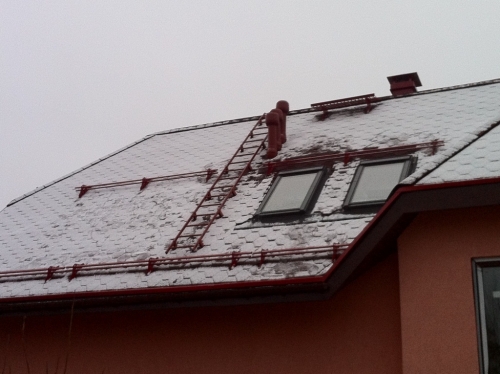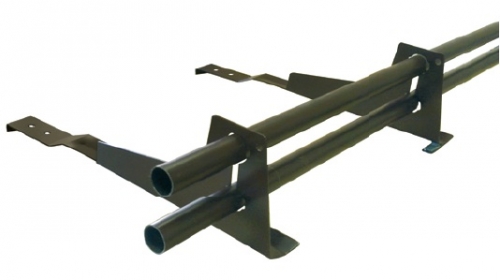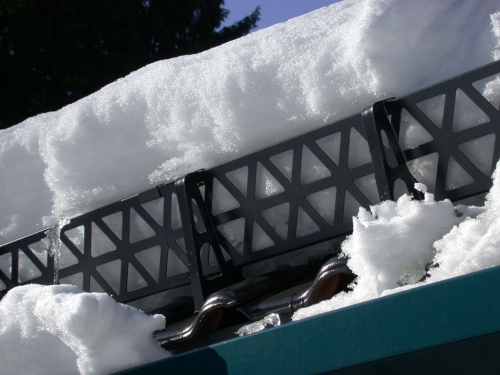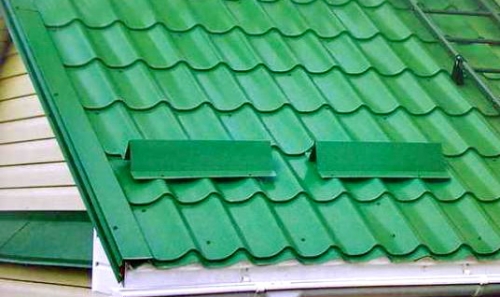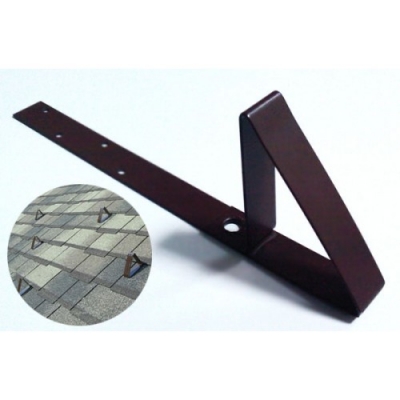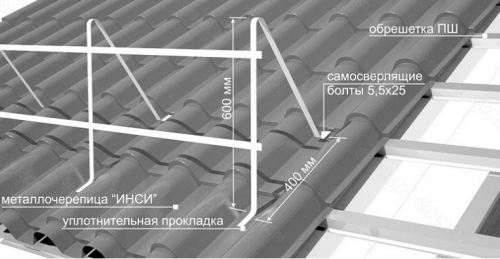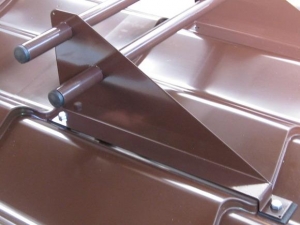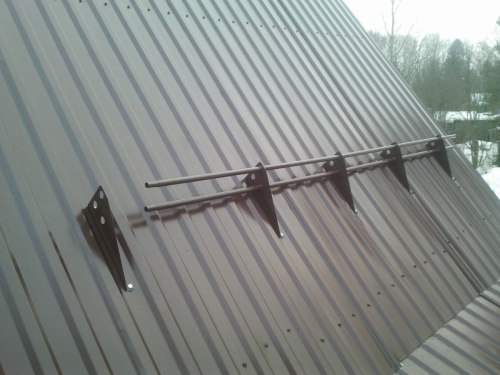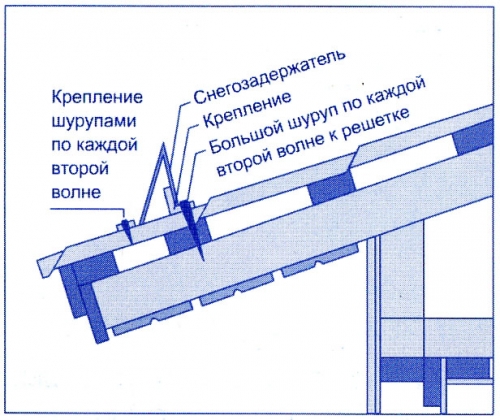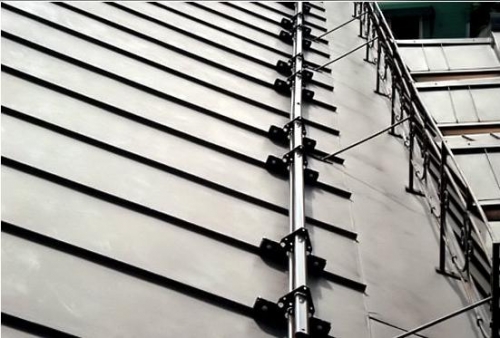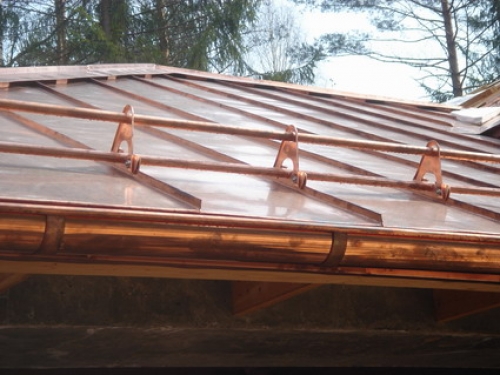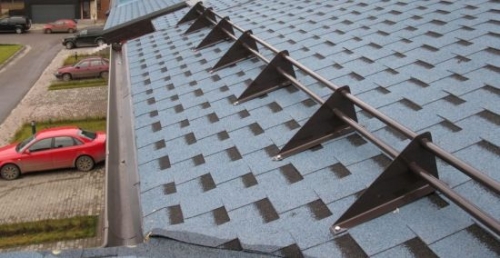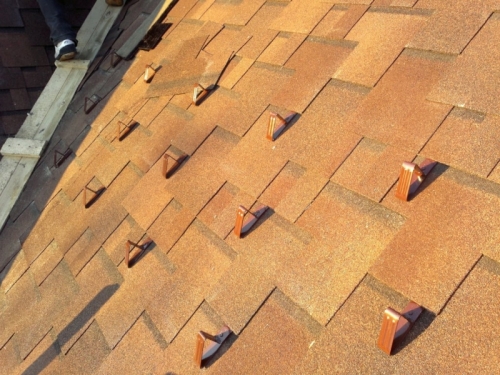For some reason, there is an opinion that, of course, is erroneous, which is on a stretch ...
|
|
Patterned ceramic tiles excellent decoration of the kitchen, bathroom or hallway. But... |
Many people, with the mere mention of the repair, grab their heads. Of course,... |
Snow holders on the roof, types and features of installation
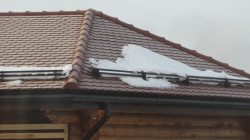
In regions with snow winters, there is a common problem with an avalanche -like snow gathering from the roof of the house, which can not only cause material damage, but also carry away the lives of passers -by. You can avoid such a problem if you install snow retainers on the roof. These structures allow you to maintain the main layer of snow on the surface of the roof. Only grunting, water from snow can flow freely along the gutters. The type of snow retainers is selected depending on a few important factors: the angle of inclination of the slope, roofing material and the amount of snow cover in the region. Let us consider in more detail what types of snow retainers are and what are the features of their installation on different roofs.
Types of snow holders for the roof
Snow holders on the roof can be bought along with roofing material during the construction of the house, or you can purchase separately when the house has already been built. In different stores, such devices can be called differently: snow-blocking fences, snowballs, snowmobiles, snow cutters, snowfalls, snowfields, and of course, snow retainers. Such a variety of names is due to the fact that these simple devices can perform different functions.
The first category snowfalls or snow -blocking fences Completely hold snow on the surface of the roof. Snow should melt on the roof naturally. The gathering of its layers is even partially unacceptable from the roof.
The second category snow cutters Designed in order to cut the overall layer of snow into small parts. Thus, his energy when falling is much lower than it would be if the entire layer of snow went an avalanche. This is enough to ensure security.
Snow holders for the roof differ not only in shape and size, but also with material and reliability of the structure. First of all, when choosing a particular type of snow retainers, it is necessary to focus on how much snow it should restrain.
Tubular snow holders
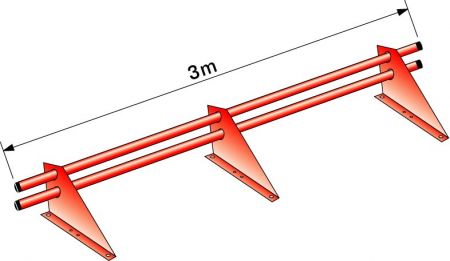
A tubular snow retainer for the roof is a design of brackets, into which two pipes with a diameter of 15 30 mm are inserted. The total height of the structure is about 15 cm. The bracket looks like a vertical plate with openings for pipes. At the bottom of the bracket horizontal shelf for attaching to the slope of the roof. Scuropes for 8x60 mm metal are screwed into it with a hexagonal head. Sometimes the type of bracket may differ depending on what type of roofing material a snow retainer will be used for. The installation method may also differ.
The strength of the design of the tubular snowman depends on the distance between the lower pipe and the surface of the roof. The distance of 2 3 cm from the roof to the first pipe and 8 10 cm between the pipes is considered optimal.
Important! Tubular snow retainers can be installed on roofs with a very large slope of up to 60. Indeed, in such cases, the snow pressure is very large and its movement occurs very often. On the roofs with a slope of more than 60, snow retainers are not installed at all, since it is believed that the snow does not linger on them and crumble immediately.
Tubular snow cutters belong to that category of snow retainers, which is designed to cut a layer of snow into several parts. These designs are considered the most reliable, are able to withstand powerful pressure of the snow layer and can be used on roofs of any type of leaf, roll soft materials, as well as from natural tiles. They are installed around the entire perimeter of the structure, along the entire slope. Moreover, the installation of tubular snow cutters is carried out in a continuous row, and not into a run. Sometimes, when the snow load is very large, two rows of snow retainers at a distance of 2 3 m from each other are placed.
The fixing of the lower row of tubular snow retainers is produced over the carrier wall, i.e. At a distance of 40 50 cm from the cornice overhang. After installation, they are practically not visible against the background of the roof, because the color of the snowman can be selected to match the color of the roof. Typically, tubular structures are made of galvanized steel, and on top are covered with a layer of paint to the color of roofing material. As a result, the product turns out to be durable, unponounced corrosion.
Lattice snow holders
Long -free snow retainers on the roof have a variety of dimensions. A universal type of structure: brackets to which a vertical grill is attached. All parts are made of galvanized steel, painted on top, so that the grilles can also be selected to match the roof. But the size of the grate can be different. The largest with a height of 15 20 cm, but there are also small ones, where the height of the grate is not more than 5 7 cm. Naturally, depending on the size, the lattice snow retainers can maintain a different volume of snow.
A large steel lattice can resist a large volume of snow masses with ice floes. As a rule, the entire layer of snow is held on the roof, including the smallest pieces of ice, and only melted water flows down.
The lattice snow retainers are installed on long slopes with a rather large bias in order to guarantee to keep the blocks of snow from the fall. The effectiveness of these actions depends on the height of the lattice. Also, the roof material also does not matter, almost all materials have their own types of fasteners.
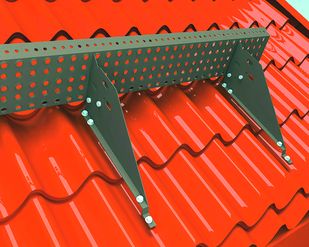
Important! Please note that tubular snow retainers are a more durable design. If the snow volume is too large, the lattice plates can bend, bend out under the pressure of the block. What does not happen to the pipes due to the strength of the structure. The strength of the lattice snowups is also affected by the shape and reliability of brackets or guides. Do not purchase flimsy products, the same thickness as the grate itself.
There are also designs of lattice snow retainers in which the grille is welded to longitudinal pipes. In this case, the product is exclusively reliable.
Installation of lattice snow retainers is carried out in a row along the slope of the slope. If the length of the slope is more than 5.5 m and the snow load in the region is large, then in addition to the lattice, other types of snowballs are also installed, for example, plate.
Corner or plate snow holders
With small volumes of snow on the roof, corner snow retainers are installed. Basically, they are mounted on roofs of metal -tank or corrugated board, since the snow retainers themselves are made of the same material and have the same color.
As can be seen on the corner snow retainers on the roof of the photo, they are metal products bent into a triangular structure with two faces and shelves for attaching to the base. The height of such snow holders is from 4 to 6 cm. Usually they are installed on the roofs, where the slope angle does not exceed 30, since they are simply not able to withstand high pressure.
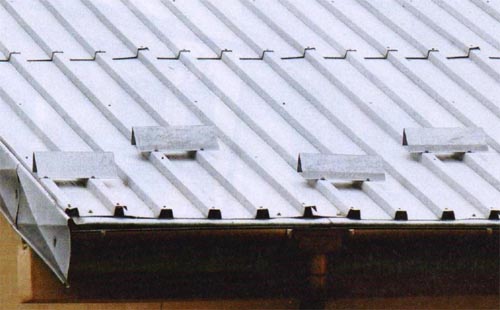
The fastening of corner snow retainers is carried out directly to the roofing material, including the upper wave of wavy materials.
Similar snowpresses are installed along the skate in a checkerboard pattern in several rows, from 2. The distance between rows is from 50 cm to 1 m.
Corner snow holders do not differ in great strength, are not able to maintain a large layer of snow from the convergence, therefore they are used in regions where there are not so many precipitation. Also, the roof must be regularly cleaned from snow.
Buggeli point snow holders
Bugelous snow holders or, as they are also called hooks, are not ways to delay any significant volume of snow, therefore they are used as an addition to the lattice and tubular snowups, as well as on a soft roof with a small slope.
On a soft roof, snow is usually delayed independently, this is facilitated by a rough surface of the material, sprinkling from granules. For example, on a bitumen tile or roofing material, snow accumulates and retains without problems. And if the slope of the roof is small, then the snow gathering is unlikely. Nevertheless, point tubell retainers are installed for security, in a checkerboard pattern at a distance of 50,70 cm from each other.
A feature of the Bugels is that they can only be installed at the stage of roof installation. They are triangles with a long plate for fixing to the crate. The plate should be located under the roofing material, and is attached to the crate, bitumen tiles are covered on top and hides the attachment. Thus, the roof is protected from leaks.
Wooden log as a snow retainer
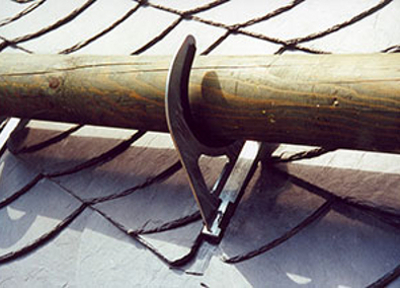
Wooden logs are used to detain snow very rarely. They can be found on an equally rare wooden roof of a sore roof or a hound roof. The logs are installed on special hooks, which are fixed to the crate or rafters of the roof structure. The larger the diameter of the log, the greater the snow volume can withstand such a snow.
The log itself is located at a small height above the surface of the roof 2 3 cm. Therefore, melting snow can flow freely to the drains. The rest of the snow is held until complete melting.
Installation of snow holders on the roof
It is best to mount snow retainers along with roofing material. Sometimes it is recommended to install snowups not along the entire perimeter of the roof, but only over important objects: pedestrian paths, car parking, attic windows and balconies. The installation sites are selected according to the calculation that when the snow avalanche with a roof with a slope of 35, the snow falling area is 0.4 1.5 m from the roof overhang.
The distance from the snow retainer to the cornice overhang should be from 50 cm to 80 cm. It is impossible to mount snow retainers directly on the cornice overhang. The exception is only the case when the cornice is formed by the rafters of the roof.
Important! If you install snow -retention structures on a cornice overhang or near it, the cornice will inevitably collapse with snow retainers and a snow avalanche. The light body design is simply not able to withstand such pressure.
For snow retainers on the roof, the price depends on the type of product, manufacturing material, size and fame of the manufacturer. And it can vary in the range from 1.5 to 230 cu
Snow holders on a roof of metal tiles
The metal tile to date is almost the most common roofing material. But its design itself suggests that snow will go very often on it. The smooth surface of the material practically does not delay snow. And the sensitivity of the material to temperature differences contributes to the fact that during the day the snow undermines and slides along the surface of the metal tile down, carrying the entire layer of snow and ice.
Given all this, snow retainers for metal tiles are simply an urgent need.
For roofs covered with metal tiles, you can use such types of snow retainers:
- Tubular;
- Lattice;
- Plastic.
The latter are used only on slopes with a small bias and in regions with low -snow winters. In other cases, tubular and lattice structures are used, as the most durable and simple in installation.
Fastening of tubular and lattice snow holders It is produced directly through the roofing material:
- We plan where the snowman will be located.
- We strengthen the crate with an additional bar.
- We assemble a set of snow retainer, but do not tighten the bolts.
- We fasten the roofing material, and drill holes under the fasteners on top. The holes should be located in the lower wave, which adjacent to the crate.
- We fix the collected bracket to the slope of 8x60 mm bolts. The holes are seized with rubber lining. The step between the brackets depends on the slope of the roof and the length of the slope. The greater the slope, the more often the brackets should be located. For example, a step 50 cm will be more than enough for the most strong design.
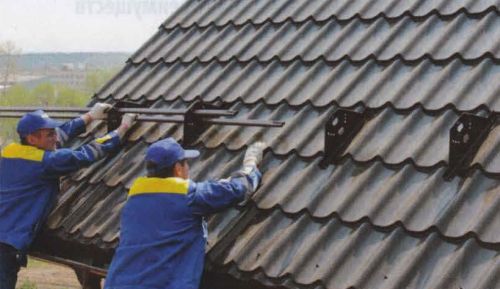
- We insert pipes into the brackets. Or if the lattice snow retainers are mounted, then we connect neighboring sets among themselves.
We remind you that it is necessary to attach snow retainers above the carrier wall. To install the snow retainer above the attic window, it is necessary to strengthen the crate.
If the slope is longer than 5.5 m, two rows of snow retainers should be installed.
Depending on the type of metal tile, the design of the supports of brackets is different. For example, for installation on Monterrera metal, snow retainers are used, whose brackets are equipped with a special protrusion. This makes it possible not to strengthen the crate.
Snow holders on the roof from corrugated board
The surface of the corrugated board is as smooth and sensitive to temperature changes as that of a metal tile. Therefore, snow holders are simply necessary to keep snow on the roof. In addition, melting snow freezes in the evening, when the next day, the melted snow begins to move along the roof, ice floes scratch the coating of corrugated board. As a result, over time, the galvanized coating is ripped off, scratches appear in which rust develops.
Just as in the case of metal tiles, for corrugated board you can use tubular, lattice and plate snow retainers. Most often use tubular snow retainers made of galvanized steel, stained in the tone of corrugated board.
Installation of snow holders on the roof from corrugated board It is practically no different from the installation on the metal tile:
- The mount is carried out through the material.
- The crate must be strengthened.
- And the holes for the fasteners are compacted with special gaskets from atmospheric rubber.
- The fastening should be located in the lower part of the wave of the corrugated board, which adjacent to the crate, otherwise the sheet will bend and conquer.
If it is planned to install snow retainers on the already finished roof, you will have to disassemble its part in order to strengthen the crate. Or the strengthening of the structure must be taken care of in advance.
To install corner or lamellar snow holders, the reinforcement of the crate is not required, since they are fixed directly to the sheet of corrugated board or metal tiles in the upper wave. The bolt must crash into the wood of the crate, otherwise the design will turn out to be fragile. The fasteners of corner snowproofs should be located through one wave.
Snow holders for the folding roof
On folding roofs, only tubular and lattice snow retainers are used. The main difference between the installation of tubular snow retainers on the fake roof is that the brackets have a kind of shape and are attached directly to the fold. Thus, the tightness of the coating is not disturbed.
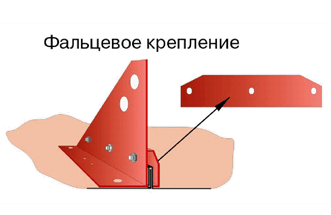
As you can see in the photo, fastening to the folds produced using clamps:
- We dress the clamp on the fold.
- We drill 2 3 holes.
- We insert bolts with nuts and twist.
- The step between the supports depends on the slope of the roof. The most reliable option is attached to each fold.
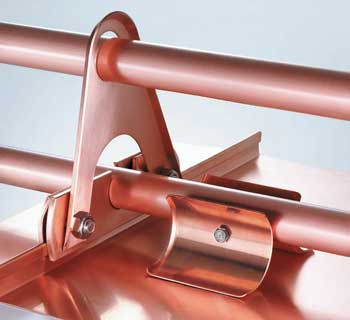
An indisputable advantage of fastening snow retainers to the fold roof is also that there is no need to strengthen the crate. All work is carried out on top, for finished roofing material. As a result, the design is quite reliable, since the main pressure of the snow is distributed along the fold.
Please note that not all snow retainers for the folding roof are made and galvanized steel. There are copper models. They are sold not by a set, but pieces: a piece of pipe, lower and upper brackets. Prices for copper snow holders are higher than ordinary, but copper folding roof is not cheap pleasure.
Snow holders for soft roof
The soft roof has its own characteristics, which leave an imprint on the choice of the type of snow retainers and the nuances of the installation:
- The roof slope angle with a soft roof should not exceed 15. With such a slope, an avalanche -like snow gathering is unlikely. Therefore, powerful tubular snow holders are practically not used.
- Sprinking from stone crumbs on the surface of soft roofing materials delays snow and prevents it from slipping.
- Due to the fact that for the installation of a soft roof, a continuous type of crate is used in the form of sheets with moisture -resistant plywood, there is no need to strengthen the crate.
- Nevertheless, all work on the installation of snow retainers on the soft roof should be carried out at the stage of laying roofing material.
For soft roofs, tubels are most often used, less often tubular snow holders.
Installation of tubular snow retainers on a soft roof practically does not differ from installation on corrugated board or metal tiles. The lack of fastening such a design is that the fasteners are on top, i.e. The tightness of the coating may be disturbed.
Triangular bugels or stoppers are attached using this technology:
- They must be placed in a checkerboard pattern in 2 3 rows with a step of 50 70 cm.
- The hill is attached to the crate so that the next sheet of soft tiles hides the fastener, and the triangle of Bugel remains from above.
- We fasten the screws.
If the roof is already mounted, the boogles can be fixed on top, in which case, gaskets from atmosphere rubber are used.
In conclusion, I would like to say that in the conditions of our snowy winters, the use of snow holders on the roofs is mandatory. Nevertheless, it is still necessary to clean the roof once a week or two depending on the volume of precipitation. You can get rid of the need to clean the roof and delay snow by installing a heating cable under the roof. Thus, the snow will immediately melt and drain along the drain. The formation of icicles and snow avalanches is excluded.

